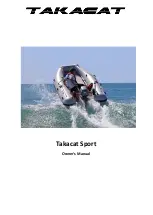
Launching Cont.
Retrieving
brake is on securely and the
vehicle is in first gear.
k. While one person holds the
launching line disconnect the
safety rope on your boat and
the winch hook from the towing
eye.
l. Push the boat off the trailer. At
most ramps the boat will roll off
the trailer very easily. lf
necessary use the tiltboom
mechanism on the trailer to
give a higher launch angle.
m.
Leaving a crew member to
hold the boat off the ramp
park your car and trailer in the
authorised parking area. Think
of your fellow boaties and Do
Not leave your vehicle in a
position which will hinder others
launching.
n.
At this point you are ready to
depart. lf you are on a busy
ramp get clear as soon as
possible to allow others to
launch.
p.
Hoist your mainsail first. Your
Farr 6000 will sail well under
main alone and you can hoist
the jib in your own time.
q.
Lower the keel and rudder
blade when water depth
permits and secure rudder
clamp and holding down lines.
Retrieving
This is largely common sense but
once again the method of approach
is effected by the wind direction.
Whatever the wind direction if you
use an auxiliary motor it is obviously
easiest to approach the ramp under
motor power only. The correct
procedure for this is as follows.
1.
While still sailing lower the
outboard bracket and start the
auxiliary motor.
2.
Allow the boat to come bow to
wind and lower and furl securely
the main and jib.
4.
Wind up the keel. The
winch is powerful and overwinding
when the keel is fully up can
damage your wire. Tighten up only
finger tight on the handle.
5.
Release the rudder clamp and
rudder tiedown cord so that the
rudder can be raised when
required.
6.
Approach the ramp
slowly
under
motor with a crew member
stationed on the bow to fend off.
7.
Raise the rudder blade clear of
the water in adequate time to
prevent it hitting the bottom and
cleat the holding cord on the
tiller.
Note:
When approaching a ramp,
wharf or other boat it is always wise
to approach
SLOWLY
and under
control, but always keep enough way
on for manoeuvering.
Approach Under Sail
lf you choose to approach under sail
with an on shore wind it is
recommended to drop and furl the
mainsail prior to approach. The run
in can then be made under jib only,
following a similar procedure as that
recommended for a motor approach
except that care should be taken to
see that the jib halyard and sheet are
clear so that the sail can be dropped
quickly and efficiently when required.
Remember that a moving boat has
some considerable momentum after
the sails have been dropped so do
not leave the jib hoisted too long. For
an offshore wind the keel and rudder
must obviously be left down until the
last moment and the sails eased and
the boat brought head to wind right
on the ramp. For the beginner we
would recommend that you practice
this manoeuvre on an empty ramp
on a light day until you have
perfected the timing.
Retrieving on to
trailer:
-
1.
Back the trailer into the water
leaving vehicle in gear and
handbrake securely fastened.
2.
Release winch wire until it can be
hooked through the towing eye
and wind the boat on to the
trailer.
lf necessary use the tilt on the
trailer for ease of retrieving.
3. IMPORTANT
Attach a safety line
from the boat to the trailer before
pulling up the ramp. Otherwise
should your winch, wire, or hook
break half way up the ramp you
could quite easily end up with the
boat falling on to the ramp. lt is a
recommended practice to always
use a safety line from the boat to
the trailer when trailering the
boat.
4.
When trailering always ease off
the keel winch so that the weight
of the keel rests on the trailer and
is not wholly taken by the wire.
13
14






























